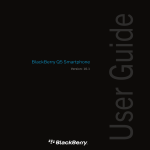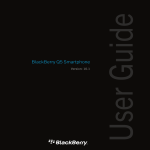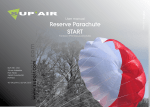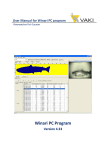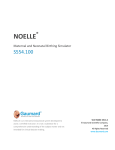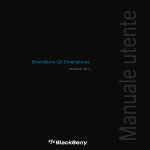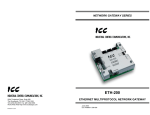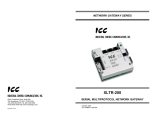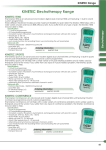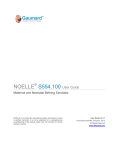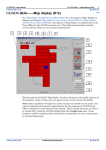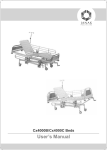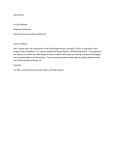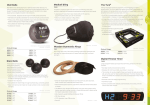Download SQR User Manual
Transcript
SQR User Manual V 1.05 INTRODUCTION Thank you for choosing the SQR reserve system. We are confident that you will be pleased with it in every respect. Please read through these instructions carefully. You can find a downloadable copy of the current version of this manual under www.companion.aero/manual. In this manual you will find the essential details you need to know about re-packing, storing, maintaining and - if needed - deploying your reserve. Please read the manual carefully before first use, to familiarize yourself with the features of your reserve system. You can reduce the risk of injury if you • pack or re-pack your reserve system according to the instructions given in this manual, • use the correct procedure when deploying the reserve, and • care for and maintain your reserve and your flying equipment according to the instructions given in this manual. We wish you safe flights and happy landings! The Companion Team www.companion.aero 2 PRODUCT REGISTRATION We recommend that you register your product online. You can easily do this by scanning the QR Code on the reserve bridle, using your mobile phone or via www.companion.aero/register. You will then benefit from: • • • • a warranty extension of one year, an online packing reminder, your personal online packing log, email notification of security issues or product updates. DISCLAIMER The SQR reserve system is certified according to EN 12491:2001 and LTF NFL II 91/09 standards. The manufacturer cannot be held liable for any possible damage to persons or material resulting from ownership or use of this reserve system. INTENDED USE AND SAFETY REQUIREMENTS This reserve system is a specially designed, manually released, reserve parachute for Paragliding, Powered Paragliding and Hang Gliding activities. The use of this reserve is not permitted in connection with any other flying activity such as parachuting, skydiving and base-jumping! Do not use the SQR reserve above speeds of 115 km/h (32m/s)! 3 REPACKING AND INSPECTION DIRECTIONS Every 12 months the reserve must be opened and aired, then repacked. This packing should be recorded in the reserve logbook. A complete inspection of the SQR reserve system must be carried out every 24 months, and be recorded in the logbook. The required repacking interval may be reduced by extreme environmental influences like humidity, sand, water, salt and other factors. If you are unsure about the effects of these, please ask a qualified professional. The way to track the maintenance/rigging history of the reserve is its online logbook, which will be automatically created for you when register the product (www.companion.aero/register). In case of a water landing, the wet reserve system should never be packed until it has air-dried completely. If the reserve parachute is dried unevenly (lines or canopy), asymmetric shrinkage may occur! The best procedure is to hang-dry the canopy upside-down, in a symmetric position (any distortions should be avoided). Do not use any heat source or machine to assist drying! If the reserve gets wet with sea salt water, the parachute should be rinsed out several times immediately in fresh water and then dried! If a reserve is allowed to dry after salt-water immersion, the salt crystals will damage the fabric and the lines, and this will compromise its airworthiness! IF THE SALT-WATER CANNOT BE RINSED OUT WITHIN 36 HOURS, THE RESERVE PARACHUTE MUST BE WITHDRAWN FROM SERVICE PERMANENTLY! 4 If the canopy shows signs of mildew or mould its strength might be affected, so it must be sent to the distributor or manufacturer for inspection. The intended life period of the reserve is 10 years. Even if you have never thrown it, we advise that you replace the reserve after this period. In addition, if you reach any of the conditions listed below, you should send in the reserve system for a factory inspection: • 20 deployments or • 40 re-packs or • high speed deployment close to or above the intended maximum operating speed (115 km/h – 32 m/s – 71mph) A factory inspection should be carried out only by a certified factory. Your local distributor will support you in such a query. To ensure that the correct materials and techniques are used, any repairs should only be carried out by the manufacturer. 5 STORAGE The reserve should always be kept in a cool and dry place. Oil, grease, paint, solvents, acids and other harmful substances should not be stored near the reserve parachute. For a long product lifespan avoid unnecessary exposure to UV rays, heat and humidity. For maximum reliability throughout its entire lifespan, always handle and maintain the SQR reserve with care. This advice applies whether the system is mounted in your harness, or if you store it separately. If you plan not to use your system for an extended period of time, you are advised to unpack the reserve and store it loosely rolled up in a permeable bag. After a long storage period (packed or unpacked) the canopy should be aired for 24 hours before repacking. The same applies if you have stored the reserve in an unsuitable environment. DESIGNER NOTES SQR - Square Round: The best of two worlds The Hybrid SQR founds a new generation of reserve parachutes, which merges the advantages of the classic round canopy and the cruciform version, to create an innovative and forward-looking technology. The SQR has been newly developed from the start, and is precisely directed to meet the needs of pilots and packers. Countless computer simulations and practical tests have been an essential part of an extensive development process. 6 Advantages of the SQR at a glance: • Improved opening behaviour, low descent values and high resistance to swinging as the result of comprehensive practical tests and an aerodynamically refined canopy with optimized Air-Jets. • Light weight due to careful choice of ideal materials and structure stiffness. • Straightforward, reliable packing - similar to a round canopy – with comparatively few lines for easy sorting, using practical packing aids and coloured packing guides. • Not trimmed to track in flight. • Tested for water landings! A mix of traditional and new materials with new low-shrink webbings means that repeated full function is guaranteed after wet landings. • Certified to both flight standards EN 12491:2001 and LTF NFL II 91/09 simultaneously, with the same technical specs. for both standards! STRUCTURAL DESIGN The basic structure of the SQR reserve is very similar to a normal round canopy reserve parachute. The system has 3 levels (see picture 1): 7 Picture 1 - General arrangement – Bottom view. 8 1. Bridle: At one end this connects the reserve to the harness, at the other to the canopy attachment lines. 2. Attachment lines can be regarded as two main groups: Base lines (all the same length for easy packing) connect the bridle to the edge of the canopy. Centre lines connect the bridle to the apex (middle) of the canopy. The two groups are made with different materials and diameters, so they can be easily separated. The lines are sewn with different thread colours on the left, centre and right side, so they are easy to separate for packing. 3. Canopy: Main canopy: made from several panels, with one red corner panel to make packing and sorting easier. Reinforcement webbings: at the edge of the canopy, and in some well-chosen places at the top. Air-Jets: ideally placed at the four corners, giving the system active aerodynamic stability. Packing loops: numbered and coloured blue on the top of the canopy (see picture 1). Differently coloured attachment loops: red, green and white – these distribute the shock loading at the canopy edge, and function as aids for sorting and packing, using the colours. 9 INSTALLING THE RESERVE We recommend that you only allow a qualified person to install your reserve in a harness. To make sure the installation will work a compatibility test is essential! Every reserve/harness/container combination has its own peculiarities. It is essential that pilots and packers/riggers familiarise themselves with the system and how it works – especially if any part of it is new (new reserve in existing harness or vice versa) – so that reliable operation can be assured. There are several ways to combine the reserve with a harness or front container. Please ask a qualified person if you are unsure about the best solution for your harness/container system. The harness manufacturer provides reserve installation instructions in the harness/container manual. Doing a compatibility test When any part of a harness/reserve combination is new or different, correct installation and functioning of your reserve in its harness/container MUST be verified with a test release, known as a compatibility test. The configuration must be tested in the in-flight configuration – with the pilot sitting in the normal flying position – and the harness suspended at its main carabiners. Any other test configuration is not adequate. For a successfully conducted compatibility test, you must be able to release and throw the reserve! For a safe reserve release, the release force at the harness reserve handle should be between 4-8daN. If you are unsure about your test results, please consult a qualified person. 10 Here are some factors which could prevent a safe reserve deployment, and so cause a failed compatibility test: • The volume of the reserve doesn’t match the allowed volume specifications for the harness/container compartment, i.e. the reserve is too big or too small to fit safely into the system. On the certification label attached to the reserve bridle you will find the packed volume for each SQR reserve model. In your harness or container manual you will find information about its permitted volume ranges. • The reserve has been installed in a wrong layout/direction in the reserve compartment space. Please refer to the harness/container manual! • The reserve is not released/thrown using the correct technique. • The reserve passed the compatibility test when first fitted into the new reserve/harness system, but now it’s too big after a repack. CAUTION: the packing volume of the reserve can vary depending on the packing style and quality. Also a reserve installed in a harness for a long period of time becomes compressed, so the volume will be less than of a freshly repacked example! Before making a compatibility test for a particular combination a repack of the reserve is obligatory. Reserves packed at the factory tend to have 10-20% less volume than a loosely repacked example 11 • The pilot’s arm length can be a factor for successful reserve throwing. Small people with short arms might sometimes not be able to release a reserve. Therefore, it is essential that the pilot flying the harness makes the compatibility test. Testing different harness types – with different body positions during flight – can help to find a solution, so that a successful compatibility test can be carried out. • Throwing is attempted under high g-loading (> 3G, e.g. in a spiral). SUCCESSFUL COMPATIBILITY TESTS CARRIED OUT BY PILOTS, PROMOTES CONFIDENCE IN THEIR EMERGENCY SYSTEMS! When the SQR reserve is installed in the harness, a suitable connector link should be used (minimal working load of 2500daN advised) for connecting the reserve bridle to the harness attachment lines/webbing. These connections should be secured with rubber o-rings, a neoprene socket or fixing tape, against fraying. We advise to use the quick-link connectors Maillon Rapide from Peguet, please ask your school or distributor where how to get them. Check if the connection link is tightened according to the specification of the link manufacturer. Direct connection between the bridle and the harness attachment webbing is not recommended, as a wrongly installed knot could significantly weaken the system depending on the configuration! 12 Installation of the reserve in its own container The reserve is delivered from the factory in its SQR container. If your harness does not have its own inner container for the reserve compartment, this could be the way to fit the reserve into the harness. There are two different attachment points for attaching the SQR inner container to the harness reserve handle. The choice depends on the shape and position of the reserve compartment in your harness. Please refer to the harness manual. On the certification label attached to the reserve bridle you will find the datum packing volume for each reserve model. Handle attachment loops Harness attachment point Certification label Picture 2 - Reserve handle attachment loops and bridle. 13 The connection between the harness reserve handle and the inner container should never be under tension when the reserve is in its installed position! Enough travel must be allowed for the reserve handle to first freely release its closure loops before applying a pull on the container. A COMPATIBILITY TEST IS ESSENTIAL, TO MAKE SURE THE SYSTEM WILL WORK! Installation in a built-in harness compartment If the manufacturer of your harness provides an inner container for the reserve compartment this could be the best way to install the reserve in the harness. The harness manufacturer provides reserve installation instructions in the harness manual. In this case, the packed reserved is removed from its own inner container and fitted into the new harness inner container. Inner container closing systems are not all the same! Please refer to the Closing the container section of the harness manual for correct fitting of the reserve in the new inner container, and then in the harness reserve compartment. If this is not done carefully the reserve system may not function correctly, or conform to its airworthiness requirements! A COMPATIBILITY TEST IS ESSENTIAL, TO MAKE SURE THE SYSTEM WILL WORK! 14 Installation in an external (front) container If your harness doesn’t have a reserve compartment, or you want to use an alternative method, you could use an external container to carry the reserve. In this case the outer-container has to be checked for airworthiness and compatibility: it has to be certified, and be the right size for the SQR reserve. Please ask for information from the container’s manufacturer or from a qualified professional. On the certification label attached to the reserve bridle, you will find the suggested packed volume for each reserve model. Please refer to the Closing the container section of the packing manual for correct reinstallation of the reserve into the new external container. A COMPATIBILITY TEST IS ESSENTIAL, TO MAKE SURE THE SYSTEM WILL WORK! USING THE RESERVE Pre-Flight check Before every flight the following should be inspected for maximum safety: • • • • Check that the reserve handle is correctly attached to the reserve. Check for any visible damage that can jeopardize the airworthiness of your equipment, Check that the container or reserve compartment cover/closure is closed/secured correctly, It is recommended, early in each flight, that you briefly put a hand on the reserve handle – to remind yourself of its location, and mentally rehearse the release/throwing action. 15 Deployment In the event of emergency, please follow these steps to successfully deploy the SQR reserve: • Grab the reserve handle with one hand vigorously. • Pull the handle out firmly in an upwards/sideways direction to release the handle closure (or any other type of handle securing system), and pull the inner container and reserve out of the harness compartment or front container. • Throw the reserve away from yourself and the paraglider as quickly and as forcefully as possible – remembering to let it go! The reserve will then open! • It is strongly recommended that a pilot actively prevents the paraglider from interfering with the reserve in flight. The best way to do this is to stall the glider by pulling both brake handles down, taking wraps as necessary. This will help to stabilize the combined system, and minimise disturbances of reserve behaviour such as swinging, scissoring, downplaning, or drifting sideways. • To avoid risk of injury, make sure that you do a parachute landing fall on landing, if possible. • If landing in water you should be aware that the air volume inside the harness back protection system can cause the harness to float and turn you head down in the water. • After landing, make sure you control the reserve by pulling the apex of the canopy in with the central lines if required. Strong wind can keep the reserve canopy inflated after landing and drag you across the ground, perhaps causing injuries. Don’t forget to find and collect the reserve inner container - you cannot repack the reserve without one. If you loose the container, please contact the reserve or harness manufacturer to get a container that fits your system. Using a wrong container will affect the airworthiness of your flying gear! 16 • After each deployment an inspection and correct re-packing of the reserve is mandatory! If the possibility of damage to the reserve system cannot be excluded, a detailed inspection should be carried out before repacking. If in doubt, please ask a qualified person. RE-PACKING, RIGGING Sorting the lines, preparing the canopy Picture 3 – Loose canopy prepared for airing. 17 Extend the lines and shake out the canopy loosely. Remember that airing the canopy for 24 hours before packing is always desirable (see picture 3). Now is the time to check for obvious twists, line-overs etc., and it should be obvious if the bridle has flipped through the lines. Now is the time to sort this out. Arrange to have the red corner split panel on top. The line of symmetry for folding runs through the centre of this panel and its white opposite number. Find the packing loops at the top outside of the canopy, numbered and marked in blue. Check that you have all the accessories and parts needed to pack the canopy: means of securing the bridle end, packing line, container, line holder, packing sticks/clamps, new rubber bands (two different sizes needed), etc. 18 Picture 4 - Packing line and loops. Red panel on top. Use a packing line and lace up the packing loops in their number order. No.1 can be found just above the red corner panel. Do not tension this line yet. Make sure you have all loops laced from 1 to 8, in the correct sequence. 19 Picture 5 - Left and right base lines at the bridle. Four middle lines in the centre. Secure the end of the bridle. Pick up the base lines for the left and right hand sides. Red for left, green for right. Keeping the lines under tension and parallel, walk along them to the canopy, keeping left and right sides separated. This will separate the canopy as shown in picture 6 on the next page. While you run the lines through your fingers, you can inspect them (the lines) for damage, dirt, etc. The base of the canopy should look like this: 20 Picture 6 - Left, centre and right lines at the canopy base. Red half panel on top, white half panel underneath. When reaching the canopy make sure that the lines at the canopy loops are all red on the left, green on the right. At the same time, the central lines MUST pass up the middle between the base lines and the edge of the canopy (top panel red – bottom panel white). If it doesn’t look like the picture . . . WARNING: ANY OTHER CONFIGURATION IS STRICTLY FORBIDDEN, AND WILL RESULT IN A POSSIBLE LINE-OVER OR LINE-TWIST! THIS IS A HAZARDOUS CANOPY MALFUNCTION AND WILL PREVENT THE CANOPY FROM OPENING. THIS MUST BE AVOIDED! 21 Picture 7 - Ready to start. Adjust and lay out the canopy so that the red panel is on top. If the layout for packing is correct, and the lines remain parallel from the bridle, the red suspension loop will be on the top of the red lines, and the green loop from the opposite side of the canopy on the bottom of the green lines. This arrangement is how the base lines should go into the left and right slots of a line holder (the four centre lines go in the middle slot). For easy work, tension the packing line with a suitable tensioner (around 1-2kg load). 22 THE BRIDLE SHOULD ALWAYS STAY UNDER TENSION SO THAT IT DOES NOT GET LOOPED THROUGH THE SUSPENSION LINES BY MISTAKE, THUS SETTING UP A LINE-OVER SITUATION! Use a flat and clean surface for packing the reserve - no contamination or foreign objects packed inside. If you are packing outdoors, use a canvas sheet as a suitable packing floor. The use of a line holder, packing clamps/sticks and packing weights can help you make packing safer, faster and easier. Folding the canopy Fold all the panels from the right side on top of the left side. This procedure in this manual assumes starting with right over left. The direction can be reversed as you wish. Now, starting with the white split (half) panel (on top), begin by neatly returning the panels one on top of the other, one at a time. The green suspension loop will confirm the starting point (underneath the finished pile). 23 Picture 8 - Right side over left and folding begins. Picture 9 - Colour layering. You should be beginning with the one short white panel as seen above, followed by 2 longer orange ones, then 2 short whites, 2 long oranges and one short red to finish the first side (see picture 9). 24 Picture 10 - Pulling out bottom and top corner. Picture 11 - Keeping a straight bottom. When laying out the panels, make sure the lines remain in the middle (line holder / packing line) and that the panels are pulled out flat. Make sure that the folds in the canopy base lie neatly on top of each other. It is advisable to first pull out the outer bottom corner ( picture 10/I.) of each panel, hold it in place and then pull out the top corner and smooth the panel (picture 10/2.). If you keep a check on the bottom edge the canopy with your hand, you can avoid mixing up the panel order. 25 Picture 12 - Clamps to hold the prepared side. Repeat the same procedure with the other side. You can use packing clamps or weights to fix the edge of the prepared half together, this will keep things tidy during the following steps. 26 Picture 13 - A prolapsed apex. Picture 14 - Remedied apex and centring the centre lines. The unloaded apex of the canopy makes a square pocket between the four lines. Sometimes it falls away (prolapses) from the centre during folding (picture 13). This pocket should be pushed back up inside between its lines – towards the packing loops, the top of the gathered canopy (picture 14). The attachment points of the centre lines should lie along the middle of the canopy. If a centre line becomes pulled to the side between the panels, readjust it to the centre (picture 14). 27 Picture 15 - Measurement of inner container widths. Make sure the bottoms of the panels are all in line. Measure up 7 container widths (around 22cm – same for all SQR sizes) along the edge of the canopy (31/2 containers from the centre to each side). 28 The next step is to S-fold one side of the canopy 31/2 times underneath, to the width of the container. This procedure in this manual assumes right as lower half. The direction can be reversed as you wish. Picture 16 - Lower half (right) folded over. 29 This is not so easy to do if you lack the practice, so it is advised that you fold the lower-part of the S-folds on top (picture 17), and then carefully flip and slide it back underneath (picture 18). A helper helps. Picture 17 - S-folding lower half on top. Picture 18 - Rotating s-fold under. You can see the procedure on the pictures above – with a figure below of how the underneath S-fold should look when finished. The red dot is the centreline of the reserve. 30 Picture 19 - Ready to S-fold left side on top. Picture 20 - S-folds complete. S-fold the other side 31/2 times, on the top. This is much easier to do, since you don’t need to flip the folded canopy part underneath. Now all the S-folds should be complete, like shown on the figure below. 31 Picture 21 - Measuring container depths– from canopy base. Picture 22 - S-fold canopy and remove packing line! The canopy is now ready to be packed into the container. Measure off container lengths starting from the canopy bottom edge, continuing towards the top (picture 21 on the left). At each point, there will be an S-Fold (positions of the clamps – picture 21). You can use weights, packing clamps or packing sticks to simplify this process. Do not leave any of these inside! WARNING: DON’T FORGET TO REMOVE THE PACKING LINE! OTHERWISE THE RESERVE WILL NOT OPEN! 32 Picture 23 - Canopy into inner container. Put the S-folded canopy into the container. You should adjust the container flaps to form a neat and tight package, by keeping the folded canopy edge in shape. You can use a temporary method (pin) to stop the container flaps opening. 33 Stowing the lines Picture 24 - Lines, pins and S-turns. MAKE SURE THAT THE BRIDLE DOES NOT GET MIXED UP WITH OR GOTHROUGH THE ATTACHMENT LINES DURING THE NEXT STEPS! Release the bridle. For stowing, the best practice is to use a line stowing base with pins. The distance between the pins should equal the width of the inner container. The best measurement for the SQR system is to use approx. 20cm pin distance The lines are wrapped around the pins in S-curves (figures of eight), as shown in the picture above. This procedure in this manual assumes right as starting corner. This can be reversed as you wish. 34 SQR 100 SQR 120 3–3 3–3 3–2 3–3 2–2 3–3 Picture 25 - S-curving the lines. After finishing a stowed group, secure it with rubber bands. Please ask the manufacturer or your distributor to get rubber bands of the right quality. Don’t use old and porous rubber bands. You should renew the rubber bands at each packing. You should stow the lines in three groups for putting in the container. In the table above (6 pins, 3 levels) you will find the number of corners to make (by model) at each pin, to have enough line-length left for closing the container (using 20cm pin distance.) Turn direction alternates at each pin to make figure of 8s. After the lines are stowed, there should be around 90cm of lines left before reaching the bridle, for closing the container safely. 35 Closing the container If you put the reserve into a different container, this should be the point where you should pick up the new packing process. If – when re-packing – the stowed line loops come open (lost a rubber band, etc.), please go back to the chapter Stowing the lines, and re-stow the whole line length. To continue with the SQR container … Picture 26 - Bundles inside, ready for final cover. Picture 27 - Closing the SQR container. … put the line bundles on top of the folded canopy (picture 26). Close the final container leaf and secure it with a line loop (picture 27). 36 Picture 28 – Put line bundles inside and check the closure loop length. Put the line bundles inside the container. The closure loop should be around 5-6 cm (approx. 3 finger width) long! DEVIATION FROM THE LOOP LENGTH CAN CAUSE MALFUNCTION AT OPENING! 37 Picture 29 - 2 line loops close the container. Close the outer flap of the container with 2 line loops of the same length (5-6cm) as used to close the inner flaps. Use the two rubber bands to secure the closing loops, by lacing the rubber bands through the grommets on the closing flap. If your container has a different closing system, please refer to the harness manual. WARNING: THE CLOSURE RUBBER BANDS ON THE SQR CONTAINER ARE STRONGER (DIFFERENT STRENGTH/DIAMETER) THAN THOSE USED FOR STOWING THE LINES! 38 Picture 30 - Finished. Now your SQR reserve is (re)packed and ready to be (re)installed. J Don’t forget to record the packing in the logbook. 39 INPECTION PROCEDURES The periodic inspection of the system is a visual inspection. The inspection should be carried out in a clean, well-lit facility by a qualified person. Canopy surface inspection Spread out the canopy – at best after airing for 24 hours – and begin the inspection by walking around the edge of the canopy. Look for rips, stains, snags, burns, abrasions or failed seams. If the canopy shows signs of mildew or mould, its strength could be compromised, so it must be sent to the manufacturer for a factory inspection. Go around the canopy in a circular pattern ending at the apex (centre). Inspect the packing loops, and the area around them carefully. Look very closely at the line suspension points. Attachment points must be completely free of any damage or defect! Suspension line inspection Fix the bridle line and walk along the suspension lines (both base and centre lines). Check the full length of the lines for damage and wear. Check that all lines are sewn and that the seams are functional. Check the bottom loops for fraying. 40 Bridle line inspection Check the bridle line for damage and wear. Look for fraying at both ends! Any fraying, either on the suspension line end, or at the harness end, means that your flying gear is no longer airworthy! Connecting link inspection Check the link and its condition. Check if the link has sufficient strength (minimal working load of 2500daN advised) according to specs of the link manufacturer. If the link is deformed, cracked or damaged it MUST be exchanged. We advise to use the quick-link connectors Maillon Rapide from Peguet, please ask your school or distributor where how to get them. Check if the connecting link is tightened according to the specification of the link manufacturer. The connection link should be secured with a rubber band, a neoprene socket or fixing tape against fraying. Any possible looseness of this connection, will result fraying and/or abrasion at a possible high speed opening. This could compromise the strength of the connection, and so the airworthiness of your system. Direct connection between the bridle and the harness attachment webbing is not recommended, as a wrongly installed knot could significantly weaken the system depending on the configuration! ANY DAMAGE FOUND IN THE PROCEDURES OF THE PERIODIC INSPECTION MUST BE REPAIRED! TO ENSURE THAT THE CORRECT MATERIALS AND TECHNIQUES ARE USED, ANY REPAIRS SHOULD ONLY BE CARRIED OUT BY THE MANUFACTURER! 41 TECHNICAL SPECIFICATIONS Model SQR100 SQR120 Area 25,4 m2 32,4 m2 Max. TOW 1 00 k g 12 0 k g Sink rate at Max. TOW 5,4 m/s 5,4 m/s Weight 1258 g 1534 g Certification EN/LTF EN/LTF SUPPORT If you have any questions or struggle to find a qualified professional, please contact us at [email protected]. 42 CERTIFICATION DOCUMENTS 43 THINK ABOUT IT! Many pilots don't give their reserve a thought. Often they have no idea what device is packed away in their harness. In addition, reserves do not always get repacked at suitable time intervals; or they may just grow too old. We have set ourselves the task of promoting an information campaign for our customers in order to raise awareness of this important subject, and interest them in relevant information. We would like to encourage our customers to make friends with their reserves; not necessarily by throwing one, but their lives could depend on this relationship. We wish you safe flights and happy landings! The Companion Team www.companion.aero 44












































